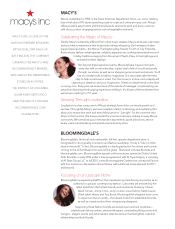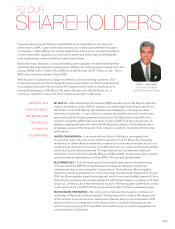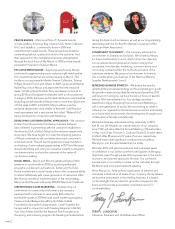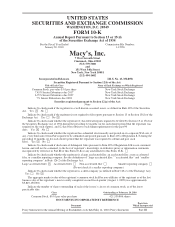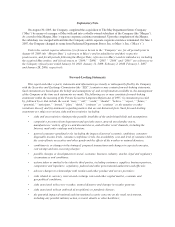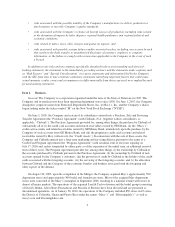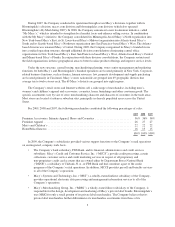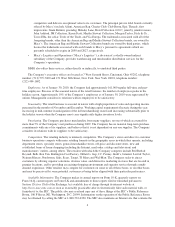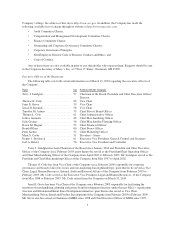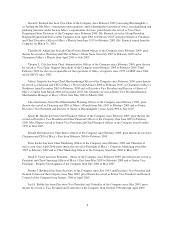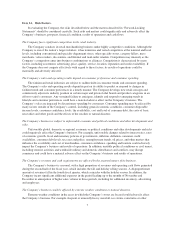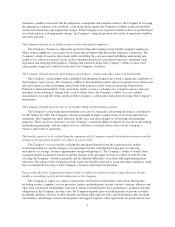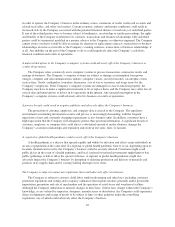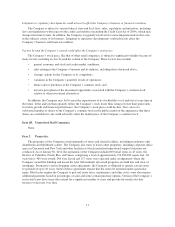Macy's 2009 Annual Report Download - page 7
Download and view the complete annual report
Please find page 7 of the 2009 Macy's annual report below. You can navigate through the pages in the report by either clicking on the pages listed below, or by using the keyword search tool below to find specific information within the annual report.Explanatory Note
On August 30, 2005, the Company completed the acquisition of The May Department Stores Company
(“May”) by means of a merger of May with and into a wholly-owned subsidiary of the Company (the “Merger”).
As a result of the Merger, May’s separate corporate existence terminated. Upon the completion of the Merger,
the subsidiary was merged with and into the Company and its separate corporate existence terminated. On June 1,
2007, the Company changed its name from Federated Department Stores, Inc. to Macy’s, Inc. (“Macy’s”).
Unless the context requires otherwise (i) references herein to the “Company” are, for all periods prior to
August 30, 2005 (the “Merger Date”), references to Macy’s and its subsidiaries and their respective
predecessors, and for all periods following the Merger Date, references to Macy’s and its subsidiaries, including
the acquired May entities, and (ii) references to “2009,” “2008,” “2007,” “2006” and “2005” are references to
the Company’s fiscal years ended January 30, 2010, January 31, 2009, February 2, 2008, February 3, 2007
and January 28, 2006, respectively.
Forward-Looking Statements
This report and other reports, statements and information previously or subsequently filed by the Company
with the Securities and Exchange Commission (the “SEC”) contain or may contain forward-looking statements.
Such statements are based upon the beliefs and assumptions of, and on information available to, the management
of the Company at the time such statements are made. The following are or may constitute forward-looking
statements within the meaning of the Private Securities Litigation Reform Act of 1995: (i) statements preceded
by, followed by or that include the words “may,” “will,” “could,” “should,” “believe,” “expect,” “future,”
“potential,” “anticipate,” “intend,” “plan,” “think,” “estimate” or “continue” or the negative or other
variations thereof, and (ii) statements regarding matters that are not historical facts. Such forward-looking
statements are subject to various risks and uncertainties, including:
• risks and uncertainties relating to the possible invalidity of the underlying beliefs and assumptions;
• competitive pressures from department and specialty stores, general merchandise stores,
manufacturers’ outlets, off-price and discount stores, and all other retail channels, including the
Internet, mail-order catalogs and television;
• general consumer-spending levels, including the impact of general economic conditions, consumer
disposable income levels, consumer confidence levels, the availability, cost and level of consumer debt,
the costs of basic necessities and other goods and the effects of the weather or natural disasters;
• conditions to, or changes in the timing of, proposed transactions and changes in expected synergies,
cost savings and non-recurring charges;
• possible changes or developments in social, economic, business, industry, market, legal and regulatory
circumstances and conditions;
• actions taken or omitted to be taken by third parties, including customers, suppliers, business partners,
competitors and legislative, regulatory, judicial and other governmental authorities and officials;
• adverse changes in relationships with vendors and other product and service providers;
• risks related to currency, interest and exchange rates and other capital market, economic and
geo-political conditions;
• risks associated with severe weather, natural disasters and changes in weather patterns;
• risks associated with an outbreak of an epidemic or pandemic disease;
• the potential impact of national and international security concerns on the retail environment,
including any possible military action, terrorist attacks or other hostilities;


